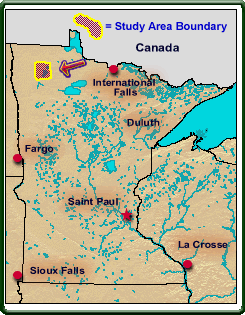Upper Midwest Environmental Sciences Center
|
|
| Home/ Overview/ Science Programs/ Data Library/ Products and Publications/States/ Rivers/Teachers and Students/ Links/ Contact/ Search |
Wildlife Contaminant Research in the Upper Midwest
The Upper Midwest, because of its importance as a transportation, agricultural, and industrial center, has many known contaminant problems. These problems are diverse and include organochlorine contamination, such as polychlorinated biphenyls, trace metal problems including acid rain and mercury, agricultural chemicals, and petrochemicals.
Many of these chemicals are of special concern because they readily accumulate in organisms and can biomagnify to high concentrations within food webs supporting fish and wildlife.
 One contaminant problem in the Upper Midwest is that of heavy metals.
For example, eggs and feathers of several bird species collected at the
Agassiz National Wildlife
Refuge in 1994 were reported to have high levels of heavy metals including
cadmium, mercury, and chromium.
One contaminant problem in the Upper Midwest is that of heavy metals.
For example, eggs and feathers of several bird species collected at the
Agassiz National Wildlife
Refuge in 1994 were reported to have high levels of heavy metals including
cadmium, mercury, and chromium.
The effects of these levels of metal contaminants on nesting birds are unknown. In this study, we are determining concentrations of heavy metals in representative bird species nesting on Agassiz National Wildlife Refuge.
Eggs and chicks of tree swallows, eared grebes, pied-billed grebes, black-crowned night herons, and Franklin's gulls were collected in 1998 and 1999 and analyzed for heavy metals.
These results will assist the U.S. Fish and Wildlife Service in
determining whether action needs to be taken to protect wildlife
resources at these sites.
The project will be completed in September 2004.
Principal Investigator: Tom Custer



